Succession Planting
I remember my early days of reading about gardening, and
the plans I made for multiple plantings of vegetables, just like in the books.
It was such an intriguing idea. Plant an early crop, harvest it, plant a
different crop, harvest it, plant again, etc. It didn't take me long to realize
those ideas and designs were for those with longer growing seasons. For most
crops it was enough to be able to get one planting to mature in my short season
garden, and that was OK.
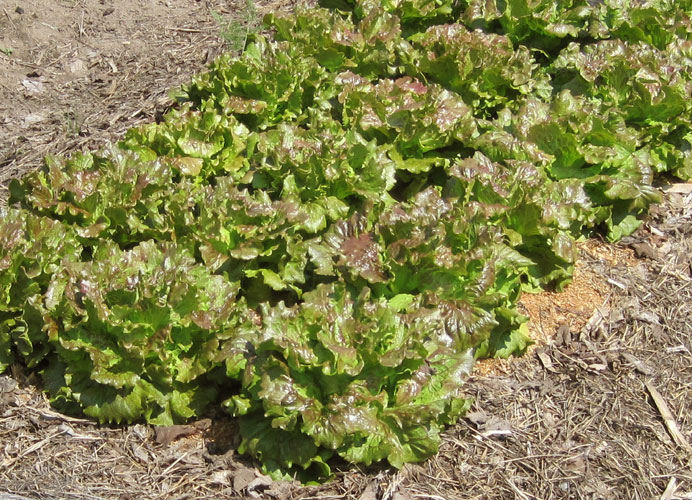 But
even we can successfully succession plant some crops. The big winners for me are
lettuce and spinach. I plant lettuce in March (inside), April, May and June in
the garden. The last one being a summer lettuce (my favorite right now is Sierra
- photo at right), the earlier ones (and later plantings) Red Tinged Winter. I
experiment with other lettuces, there are so many options, but always come back
to these two. As the new crop matures the previous one is pulled and the area
mulched or planted with something else. In August and September I'm planting
again for fall eating and to transplant to the greenhouse for winter. In October
seed is planted in the greenhouse for late winter/early spring. Lettuce is
pretty much a year round crop for me. In the garden the plants are 12" apart; in
the greenhouse they are grown closer and smaller in flats. But
even we can successfully succession plant some crops. The big winners for me are
lettuce and spinach. I plant lettuce in March (inside), April, May and June in
the garden. The last one being a summer lettuce (my favorite right now is Sierra
- photo at right), the earlier ones (and later plantings) Red Tinged Winter. I
experiment with other lettuces, there are so many options, but always come back
to these two. As the new crop matures the previous one is pulled and the area
mulched or planted with something else. In August and September I'm planting
again for fall eating and to transplant to the greenhouse for winter. In October
seed is planted in the greenhouse for late winter/early spring. Lettuce is
pretty much a year round crop for me. In the garden the plants are 12" apart; in
the greenhouse they are grown closer and smaller in flats.
 Spinach
is similar, planted rather close to begin, thinned (and eaten) as they grow to
finally be about 8" apart. I used to plant them in a block but found they grew
much better, bigger, and bolted later when planted in single rows along the
outside edges of the plots. The first spinach is planted in a cold frame as soon
as the snow is gone, then about every two weeks through June, skip July, again
in August and September, heading then into the greenhouse for winter. I've found
the greenhouse spinach grows much better in the bed than it does in Spinach
is similar, planted rather close to begin, thinned (and eaten) as they grow to
finally be about 8" apart. I used to plant them in a block but found they grew
much better, bigger, and bolted later when planted in single rows along the
outside edges of the plots. The first spinach is planted in a cold frame as soon
as the snow is gone, then about every two weeks through June, skip July, again
in August and September, heading then into the greenhouse for winter. I've found
the greenhouse spinach grows much better in the bed than it does in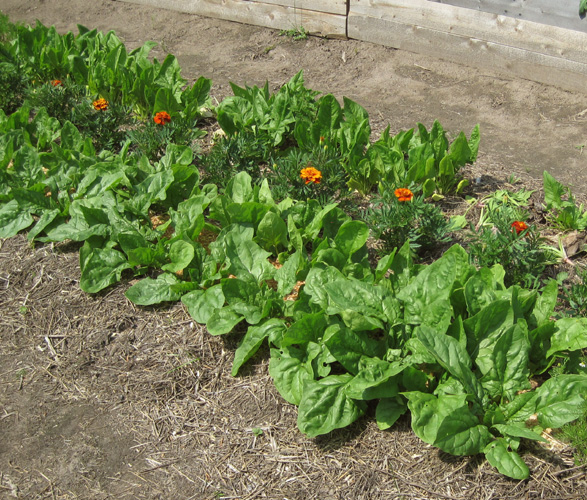 flats. Each planting is eaten until it starts to bolt then the best leaves dried
for winter soups. Every year is different depending on the weather, and
greenhouse conditions, but in the best years we can eat fresh spinach almost all
year. Mostly it is in cooked meals but also fresh in salads.
flats. Each planting is eaten until it starts to bolt then the best leaves dried
for winter soups. Every year is different depending on the weather, and
greenhouse conditions, but in the best years we can eat fresh spinach almost all
year. Mostly it is in cooked meals but also fresh in salads.
I sometimes experiment with newer spinach varieties but
my mainstay is an old semi-savoy, moderate green, reliable variety named
Victoria. The seed came from a Seed Saver Exchange member many years ago and
I've saved my own seed since (spinach is an easy crop to grow and save seed
from). I usually also grow the darker Winter Bloomsdale. I like the thicker
"regular" spinach in the greenhouse but the lighter Victoria is more reliable.
It's so nice to have crops that are easy to grow, great
to eat, and for the most part very reliable. These are by far my main and most
important "greens"
April
29, 2021 --
Early Harvests
This is the time of the year that a few humble plants get a lot of
attention from me. As the winter crops in the greenhouse fade
or are eaten away I'm anxious for fresh outside greens. It is early yet
for most garden plants, temperatures below freezing still common, so I
doubly appreciate these hardy souls. Besides being welcome edibles these
plants are also easy, independent, and reliable. And they don't need to
be planted each year, or at all, by me. They do just fine on their own.
The one I make the most use of,
both now and again in the late fall, is Garden Sorrel, a tasty leafy edible
perennial.
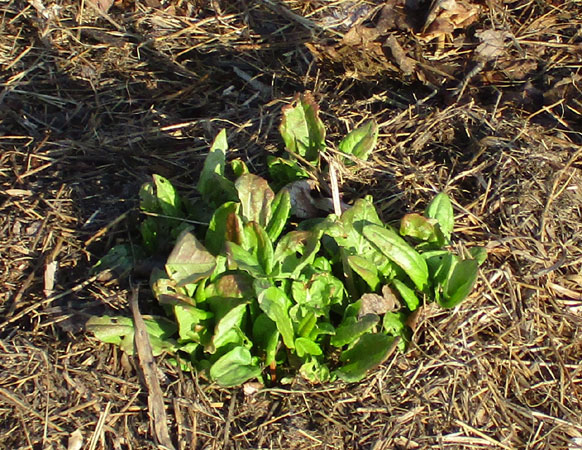
It's a sour (oxalic acid) leaf, though I guess lemony or zesty might
sound better, and is appreciated for extra salad greens. It adds a bit
of zing and is good mixed with milder lettuce, which is often in short
supply right now. It works as a cooked green, too, though I don't use it
that way very often. It is very similar in taste to wild Sorrel (which
we have in plentiful supply) but much larger leaves and so much easier
and more convenient to harvest. Right now the leaves are small since
they've just started growing, and this human keeps picking them, but it
won't be long before they are 4-6" and well outpacing my harvests. They
thrive in a garden plot but a few years ago I dug a clump into the
orchard "lawn" between an apple and a gooseberry and it is growing just
fine there, companioning well with the grass.

Some years there is Spinach in the garden that has overwintered well
without being eaten by someone other than me. This year I have two
plants which survived and are re-growing nicely, the fresh leaves
appreciated. But they don't go far, and it's hard to decide whether to
use them in luncheon salad or in dinner. There is still dried spinach to
use but right now I'm looking for fresh, so I turn to other growing
green things. While other crops may be in short supply, there is one we
have in abundance -- Leeks! They don't take the place of spinach but
they do add a nice mild flavor to a meal and I often harvest a half
dozen or so leaves to add to what else I have. Though the south and east woods
are carpeted with leeks we didn't used to have many near the house. But
I transplanted a couple clumps under the wild apple near the shop and
they apparently love the site, spreading and providing easy harvest.
There are also clumps growing here and there, wild-planted. I
don't make use of the bulbs though they certainly are edible. They're a
little
small, fussy and pungent for my taste. Onion are easier. But when the
stored onions run out and the new ones not ready yet, then leeks are a
readily available option.

Chives are pervasive, some might say invasive, on our homestead and
literally on our home since we planted it there when we first buried the
roof and it has thrived ever since. Actually, it thrives about anywhere.
I long ago stopped growing it in the garden and let it grow wherever it
wants. Though the young chives are a bit thin yet they are already
giving our salads a bit more green and a light chivy flavor. And it
won't be long before they will also be providing beautiful lavender
flowers. What a cheery plant.
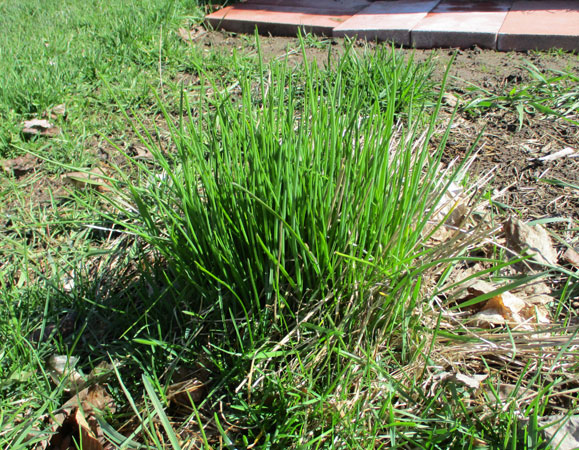
We have plenty of dandelions and there are always some nice plants in
the garden, in spite of the trowel-wielding-gardener. I occasionally
cut up some leaves to add to dinner greens, probably more because it
seems like one should than because they add much. But mostly I leave
them to flower for the bees. One has to admire their hardy tenacity
though. I like having them around.
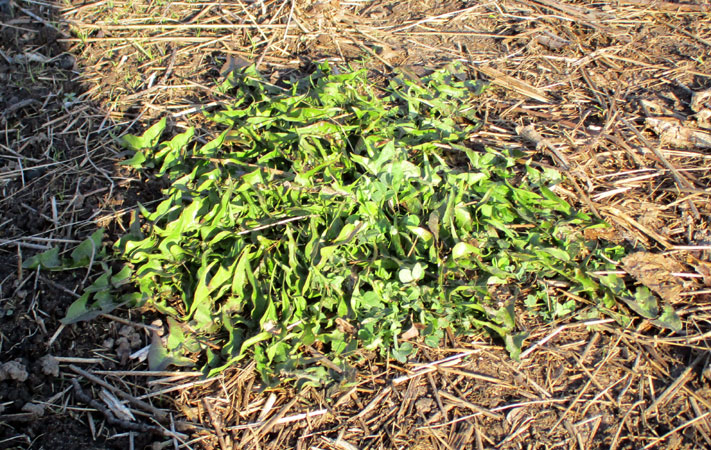
Long ago I planted some Johnny Jump Ups in my garden, not realizing how
prolifically self seeding they are. Decades later they still pop up to
be, mostly, weeded out. But I let some go. They're so persistently
cheerful. They are flowering already, before even the dandelions. Though
I seldom pick the flowers for our own salads I've added them as a
colorful garnish to a potluck dish. But I do dry some for my mixed herb
tea. They're quite mild flavored but they add a nice color touch,
especially mixed with white and yellow chamomile flowers. Mostly I share
them with the bees and just enjoy their easy flowering.
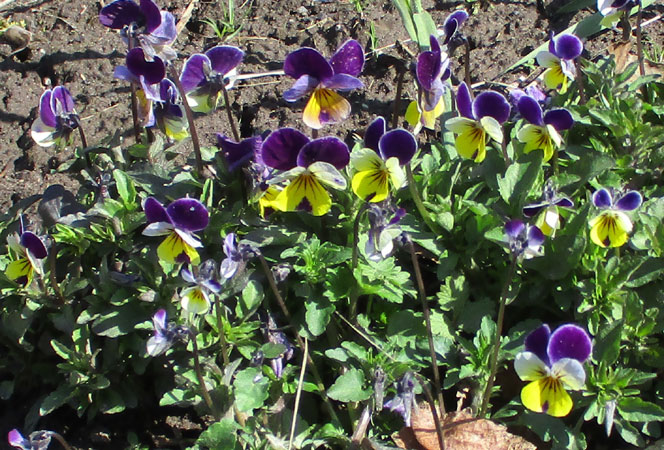
Now rhubarb isn't destined for the lunch salad, or dinner, and the stalks
aren't near large enough to harvest yet, but it won't be long. And
spring is when we really enjoy that flavor, cooked with (plenty of)
brown sugar or maple syrup and mixed with last fall's canned applesauce
-- mmmm, I can taste it already! It's fresh and tart and juicy, and at
least a few bites of the raw stalk is a necessary spring ritual. Rhubarb
is also about the very first edible that starts growing when the snow
has receded, then I know Spring is coming.
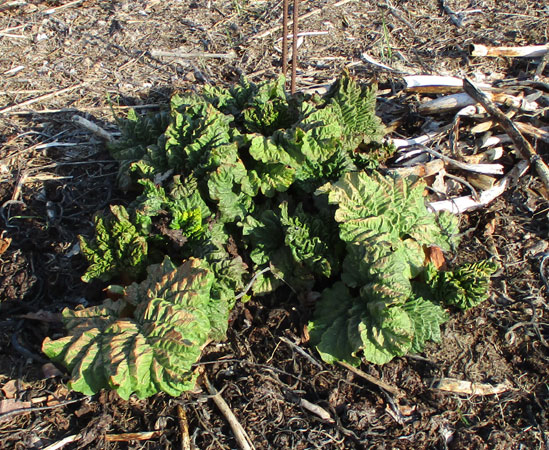
Oh yes, LilliB reminds me, I almost forgot a most important one.
Generally the fenced garden is of no particular interest to her, but
this time of year she often leads me to the gate when she is out and
about and I start heading that way. There are rituals to follow. We go
in and head straight for ... the Catnip, of course. Well, a bird or bug,
or something might distract for a few moments, but the destination is
pre-determined. Being scritched and rubbed and petted while munching a
Catnip snack -- ahhhh, life is good. This is her kind of salad. Then off she goes to check out all
the other so interesting spots that the garden and orchard has to offer.
But when I leave, she leaves. It's time to go back to the shop and
harass the chipmunk.
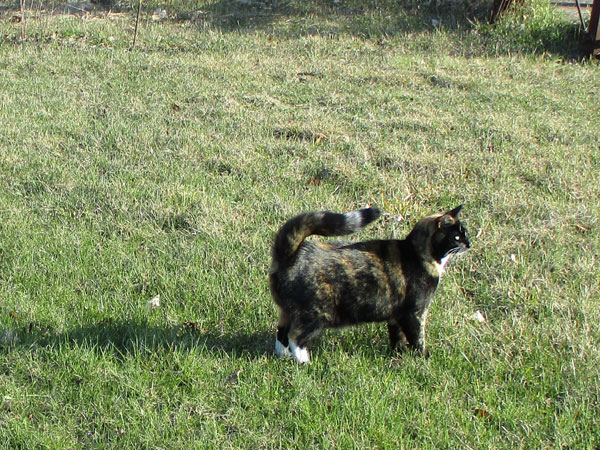
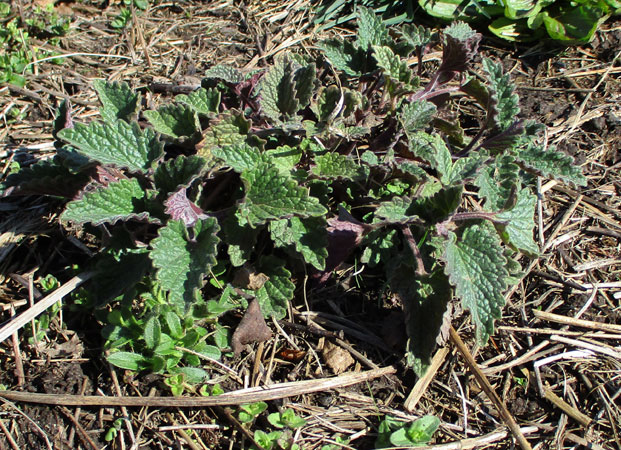
Summer Lettuce - July 24, 2017
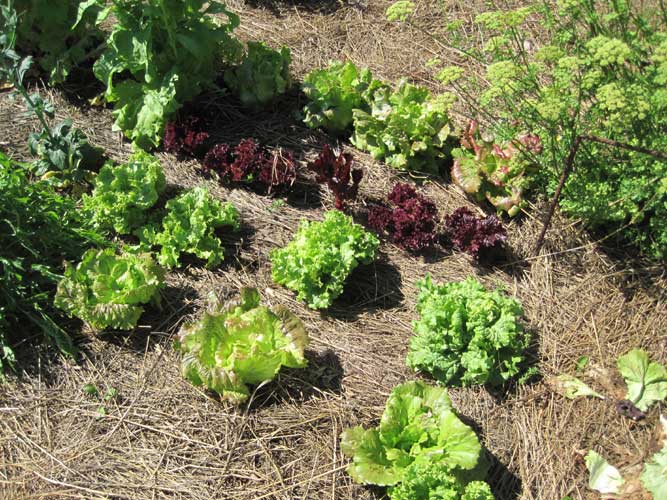 Summer
is the time we appreciate crisp fresh lettuce from the garden the most. But the
heat that makes summer what it is (well, most years) isn't conducive to
crispness in the lettuce patch, so I've been searching for varieties that suit
our salad bowl in the heat as well as the cool. My favorite thus far has been
Sierra, a green/red wavy firm crisp leaf lettuce. It's my 'go-to' lettuce from
spring to frost and it never goes whimpy on me no matter the weather, except for
frost. It doesn't like frost. But I like it enough to cover it for those
first fall frosts, until it gets really cold. It's the lettuce top and bottom in
the photo. The dark burgundy in the center isn't particularly crisp but it's so
pretty and frilly I grow it simply for the added color in our salads. It's a
nice enough lettuce called Revolution. The other, between the Sierra
and Revolution in the photo, is Green Ice. It is quite frilly and nicely garden crisp, fine textured, hardy, tasty, handles frosts and some
freezes (in a cold frame) with true yooper grace. With this trio of fresh from
the garden lettuces we are never without our
luncheon crispy salad greenery. Summer
is the time we appreciate crisp fresh lettuce from the garden the most. But the
heat that makes summer what it is (well, most years) isn't conducive to
crispness in the lettuce patch, so I've been searching for varieties that suit
our salad bowl in the heat as well as the cool. My favorite thus far has been
Sierra, a green/red wavy firm crisp leaf lettuce. It's my 'go-to' lettuce from
spring to frost and it never goes whimpy on me no matter the weather, except for
frost. It doesn't like frost. But I like it enough to cover it for those
first fall frosts, until it gets really cold. It's the lettuce top and bottom in
the photo. The dark burgundy in the center isn't particularly crisp but it's so
pretty and frilly I grow it simply for the added color in our salads. It's a
nice enough lettuce called Revolution. The other, between the Sierra
and Revolution in the photo, is Green Ice. It is quite frilly and nicely garden crisp, fine textured, hardy, tasty, handles frosts and some
freezes (in a cold frame) with true yooper grace. With this trio of fresh from
the garden lettuces we are never without our
luncheon crispy salad greenery.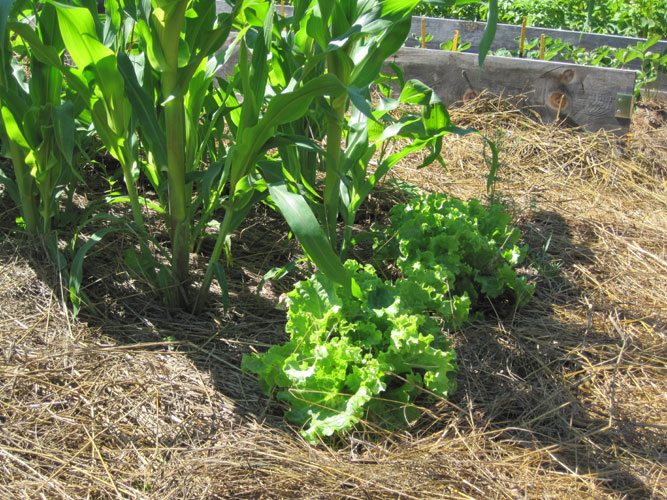
Since the hot July days are difficult for any salad I thought this year I'd help
mine along by planting the July/August crop under the shade of the corn. Well,
first of all, we aren't having a hot July this year, we're having a wet July
(and June, and May, and who knows about August!) so heat hasn't been a big
concern. Secondly, I don't think the lettuce cared that much about being helped.
All three varieties, plus another, grew OK and looked good, but even though, or
maybe because?, we aren't having real hot weather, the corn shaded lettuce just
isn't nearly as sturdy or crisp as that grown out in the open in the full sun.
Lesson learned. Don't over fuss!
Copyright
© Susan Robishaw |
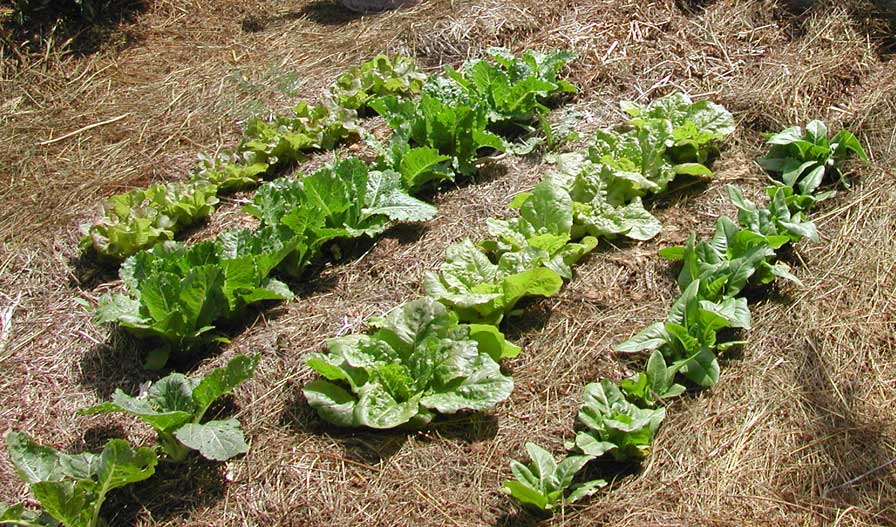



 But
even we can successfully succession plant some crops. The big winners for me are
lettuce and spinach. I plant lettuce in March (inside), April, May and June in
the garden. The last one being a summer lettuce (my favorite right now is Sierra
- photo at right), the earlier ones (and later plantings) Red Tinged Winter. I
experiment with other lettuces, there are so many options, but always come back
to these two. As the new crop matures the previous one is pulled and the area
mulched or planted with something else. In August and September I'm planting
again for fall eating and to transplant to the greenhouse for winter. In October
seed is planted in the greenhouse for late winter/early spring. Lettuce is
pretty much a year round crop for me. In the garden the plants are 12" apart; in
the greenhouse they are grown closer and smaller in flats.
But
even we can successfully succession plant some crops. The big winners for me are
lettuce and spinach. I plant lettuce in March (inside), April, May and June in
the garden. The last one being a summer lettuce (my favorite right now is Sierra
- photo at right), the earlier ones (and later plantings) Red Tinged Winter. I
experiment with other lettuces, there are so many options, but always come back
to these two. As the new crop matures the previous one is pulled and the area
mulched or planted with something else. In August and September I'm planting
again for fall eating and to transplant to the greenhouse for winter. In October
seed is planted in the greenhouse for late winter/early spring. Lettuce is
pretty much a year round crop for me. In the garden the plants are 12" apart; in
the greenhouse they are grown closer and smaller in flats. Spinach
is similar, planted rather close to begin, thinned (and eaten) as they grow to
finally be about 8" apart. I used to plant them in a block but found they grew
much better, bigger, and bolted later when planted in single rows along the
outside edges of the plots. The first spinach is planted in a cold frame as soon
as the snow is gone, then about every two weeks through June, skip July, again
in August and September, heading then into the greenhouse for winter. I've found
the greenhouse spinach grows much better in the bed than it does in
Spinach
is similar, planted rather close to begin, thinned (and eaten) as they grow to
finally be about 8" apart. I used to plant them in a block but found they grew
much better, bigger, and bolted later when planted in single rows along the
outside edges of the plots. The first spinach is planted in a cold frame as soon
as the snow is gone, then about every two weeks through June, skip July, again
in August and September, heading then into the greenhouse for winter. I've found
the greenhouse spinach grows much better in the bed than it does in flats. Each planting is eaten until it starts to bolt then the best leaves dried
for winter soups. Every year is different depending on the weather, and
greenhouse conditions, but in the best years we can eat fresh spinach almost all
year. Mostly it is in cooked meals but also fresh in salads.
flats. Each planting is eaten until it starts to bolt then the best leaves dried
for winter soups. Every year is different depending on the weather, and
greenhouse conditions, but in the best years we can eat fresh spinach almost all
year. Mostly it is in cooked meals but also fresh in salads. 








 Summer
is the time we appreciate crisp fresh lettuce from the garden the most. But the
heat that makes summer what it is (well, most years) isn't conducive to
crispness in the lettuce patch, so I've been searching for varieties that suit
our salad bowl in the heat as well as the cool. My favorite thus far has been
Sierra, a green/red wavy firm crisp leaf lettuce. It's my 'go-to' lettuce from
spring to frost and it never goes whimpy on me no matter the weather, except for
frost. It doesn't like frost. But I like it enough to cover it for those
first fall frosts, until it gets really cold. It's the lettuce top and bottom in
the photo. The dark burgundy in the center isn't particularly crisp but it's so
pretty and frilly I grow it simply for the added color in our salads. It's a
nice enough lettuce called Revolution. The other, between the Sierra
and Revolution in the photo, is Green Ice. It is quite frilly and nicely garden crisp, fine textured, hardy, tasty, handles frosts and some
freezes (in a cold frame) with true yooper grace. With this trio of fresh from
the garden lettuces we are never without our
luncheon crispy salad greenery.
Summer
is the time we appreciate crisp fresh lettuce from the garden the most. But the
heat that makes summer what it is (well, most years) isn't conducive to
crispness in the lettuce patch, so I've been searching for varieties that suit
our salad bowl in the heat as well as the cool. My favorite thus far has been
Sierra, a green/red wavy firm crisp leaf lettuce. It's my 'go-to' lettuce from
spring to frost and it never goes whimpy on me no matter the weather, except for
frost. It doesn't like frost. But I like it enough to cover it for those
first fall frosts, until it gets really cold. It's the lettuce top and bottom in
the photo. The dark burgundy in the center isn't particularly crisp but it's so
pretty and frilly I grow it simply for the added color in our salads. It's a
nice enough lettuce called Revolution. The other, between the Sierra
and Revolution in the photo, is Green Ice. It is quite frilly and nicely garden crisp, fine textured, hardy, tasty, handles frosts and some
freezes (in a cold frame) with true yooper grace. With this trio of fresh from
the garden lettuces we are never without our
luncheon crispy salad greenery.